Note You are currently viewing a previous version of this narrative statement as published in previous iterations of the KEF (KEF1 and KEF2). View the latest version
Institutional Context
Summary
Buckinghamshire New University’s (Bucks) mission is to transform lives through inspiring, employment-focused education, enabling people to build a better world. Research and knowledge exchange activity enriches our inclusive learning community. It will help us reach out to the public, to our communities, and to our key strategic partners. It will help us to innovate and continually improve our enquiry-based education.
With Bucks’ applied focus, Bucks research and KE activities arise due to professional practice or educational need, with practitioners, stakeholders and service users at the heart of its development.
Institutional context
Buckinghamshire New University’s (Bucks) mission is to transform lives through inspiring, employment-focused education, enabling people to build a better world. Research and knowledge exchange activity enriches our inclusive, learning community. It will help us to innovate and continually improve our enquiry-based education.
Bucks focuses on degrees that are professional and practical, as well as academic; offering high quality, applied-focused university courses ranging from nursing, health and social care, to cyber security, textiles and aviation. Established as a vocational teaching institution in 1891, Bucks received university status in 2007. Bucks’ diverse student body has a high proportion of students from ethnic minorities and from low-participation areas. The diversity in our student body reflects our longstanding and highly successful work in reaching under-represented groups in higher education. We provide an environment and form of education that meets their needs and we support them into high levels of graduate employment. In 2020, graduate outcomes data published by the Higher Education Statistic Agency (HESA) shows that Bucks has one of the top employment rates in the UK as 98% of our graduates were in, or about to start, employment or further study within 15 months of graduation.
Bucks was one of the first HEIs to develop higher degree apprenticeship programmes as partnerships between industry and higher education institutions. Programmes have been developed in Health and Social Care, Policing, Leadership, in addition to the Professional Academic Programme.
The professional practice focus of our educational provision underpins our KE activity through established local, regional and national partnerships and networks. These lead to development of wider needs led KE activities beyond our core teaching provision.
Through our applied focus, Bucks’ research and KE activities arise due to professional practice or educational need, with practitioners, stakeholders and service users at the heart of its development. Some of our partners include Thames Valley Police, Buckinghamshire NHS Healthcare Trust, West London Mental Health NHS Trust, Buckinghamshire Council, Chiltern Landscape partnership, High Wycombe Museum, Ad Astra teacher training network and the Traveller Movement.
Bucks Research and Enterprise Strategy for 2018 - 2023 includes objectives specifically related to KE:
Build our capacity in distinctive and impactful collaborative research through widened public and stakeholder engagement.
Develop the number and significance of our external research and enterprise partnerships so as to maximise access to funding and support KE.
Maximise the synergies between research, our curriculum and our teaching, contributing to future TEF and KEF submissions by ensuring that our academics are able to exploit the two-way interplay between research and the development of new and existing curriculum and teaching.
Bucks KE activities are primarily focused on:
Collaborative research: Academic research commissioned by sector needs and funded by health care, charities and government departments and competitively sourced collaborative projects.
Collaborative training: Enabling researchers to develop the relevant skills to undertake impactful KE, work effectively in professional practice and exploit the outcomes of their research.
People and information exchange: While recently focussed within EU-funded programmes, new initiatives are underway to support local innovation and business growth.
For further information, please send queries to lisa.mcginty@bucks.ac.uk
Local Growth and Regeneration
Summary of approach
As an anchor institution within Buckinghamshire, Buckinghamshire New University is leading an innovative growth programme to help solve local and national health and social care challenges by introducing business innovations to market. The ERDF-funded programme, called Bucks HSC Ventures, benefits early stage start-up companies because it provides unique access to market for these new technologies. Other delivery partners include Buckinghamshire Healthcare Trust; Buckinghamshire Council; Buckinghamshire Clinical Commissioning Group, and the Oxford Academic Health Sciences Network. For more information, visit the Programme’s website hscventures.co.uk. This Programme not only is on track to meet all of its desired outputs, but it has become the cornerstone for one of four of the region’s Local Industrial Strategy workstreams.
Aspect 1: Strategy
Bucks HSC Ventures (https://www.hscventures.co.uk/), a 3-year European Regional Development Fund (ERDF) virtual accelerator programme, was established in Summer 2018 in order to:
Support health and social care entrepreneurs to generate viable businesses and commercialize innovations
Demonstrate that Buckinghamshire is “open for business” to work with innovative SMEs
Develop a pipeline of innovative SMEs to support business creation
Support faster commercialization and adoption into the health and social care sector
The programme is led by Buckinghamshire New University and expertise is provided by the programme partners (Buckinghamshire New University, Buckinghamshire Healthcare Trust, Buckinghamshire Clinical Commissioning Group, Buckinghamshire Council and Oxford Academic Health Science Network) in the form of matched funding for their time.
The partners already work to support a culture of innovation in their own organisations and regionally, but this partnership, focused on health and social care, offers Buckinghamshire a novel mechanism for growing businesses and to support the development of the region’s health, social care and MedTech economies.
Bucks HSC Ventures offers a unique opportunity for innovators to work alongside academics, clinicians, provider organisations and payors (commissioners) within the health and social care system to develop and co-create innovations that meet the needs and priorities of the local area, and which have potential for regional, national and global impact.
The Programme operates in a region with a dynamic life and health sciences ecosystem. Buckinghamshire is located within a strong regional life sciences cluster, with over 700 life science companies in the diagnostics, digital health, MedTech and associated industries. Buckinghamshire has a number of global industry leaders in healthcare including: Janssen/Johnson & Johnson; and GE Healthcare. Investment into the cluster is substantial and, over the last few years, has led the UK in terms of capital investment in the life sciences (over £142M raised representing 43% of total UK fundraising in life sciences). The region also represents the largest presence of in-patient capital (over £1.2 billion in funds). There are good opportunities to leverage the breadth and depth of this ecosystem for local and regional benefit and in supporting business growth. (Source: https://www.oxfordahsn.org/)
Interactive maps are available at healthandwealthoxford.org detailing businesses by sector and organisation.
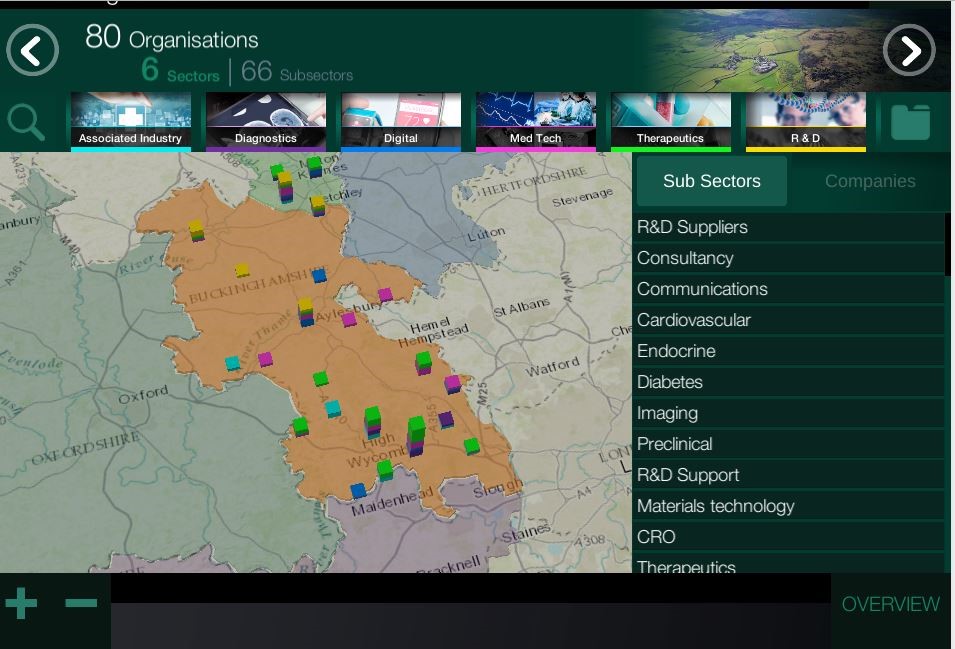
Situated within the Golden Triangle and well connected to Oxford, Milton Keynes, the Thames Valley and Reading, as well as London, Buckinghamshire is ideally placed to support health and social care focused start-ups, small and high-growth SMEs. The proposed improvements in transport links between Oxford and Cambridge, as well as planned economic investment in the “ARC”, offer opportunities for Buckinghamshire to play a role in shaping the supercluster. In particular, the county can offer a real-world “testbed” environment for innovators to co-create, test and validate their products within the health and social care system through a close partnership between academia, the NHS and industry. This alignment between “technology push” and “system pull” is an important “value add” to the region.
Digital Health, which is one area of focus for Bucks HSC Ventures, represents a sizeable opportunity for economic growth. Deloitte analysis of the UK digital health market shows significant increases in market size.
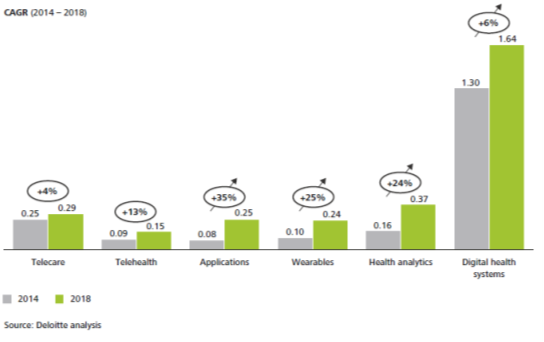
Recent analysis of the digital health assets within Oxford AHSN region, demonstrates the region to be a strong digital health cluster (Source: http://www.healthandwealthoxford.org/wp-content/uploads/2016/11/Digital-Health-in-Oxford-Wider-Region.pdf).
Both the Buckinghamshire Council’s social care and public health teams are currently interested in the potential for digital health to significantly address challenges they face in managing demand for services and improving population health and promoting healthy lifestyles and well-being. This will create a ‘pull’ to attract innovators into Buckinghamshire to co-create solutions.
Aspect 2: Activity
Bucks HSC Ventures provides a unique offering to innovators and industry by providing the following, which differentiates it in the marketplace and also acts as a pull to the region:
Access to clinicians and staff within an NHS Trust with high quality services; in particular, cardiac, stroke, rehabilitation, ophthalmology, dermatology, and the globally renowned National Spinal Injury Centre (NSIC)
Access to a team drawn from the five partners that advises innovators on the strength of their product, its place in clinical pathways, and organises necessary product testing, and validation projects in the dedicated clinical testing environments within both hospital sites
Access to budget holders (health and social care commissioners) who are the decision-makers regarding which innovations are purchased and implemented within clinical pathways. Involvement of the commissioners at an early stage of assessment, co-production and innovation of business cases is likely to increase the adoption and uptake of innovations locally
Access to budget holders focused on an integrated healthcare system (one of the first in the UK)
Access to lecturers and technicians within a strong skills-based university with credibility in health care training, product design, and with CAD, 3D printers and digital design facilities able to support innovators develop prototypes and products applicable to health and social care
Access to specialised clinical environments such as state-of-the-art clinical simulation wards and theatre simulation suites at Buckinghamshire New University and the upper limb rehabilitation facility at Stoke Mandeville
Access to state-of-the-art elite athletic performance and sports medicine facilities, including 3D cameras and motion sensors for gait analysis at the University
Access to an AHSN within a strong life sciences cluster, with a strong track record in clinical networks, supporting SMEs, wealth creation and clinical innovation adoption
Access to mentoring opportunities with Janssen/Johnson & Johnson and GE Healthcare, and other local companies
Access to fast road and rail networks to London, Oxford, and wider South East region, and access to numerous airports
Access to a range of facilities attractive to start-ups and entrepreneurs through Bucks Hubs, which is incubation workspace run by Oxford Innovation. (https://www.bucks-hubs.co.uk/)
Flexible and affordable workspace
Virtual office service (postal address, telephone call forwarding, etc.)
Hot desk rental options
Broadband and fibre-optic Internet
Board and various sized meeting rooms with tele-conferencing and projection facilities
Networking opportunities
Access to an Entrepreneur-in-Residence (https://www.bucks-hubs.co.uk/2020/01/27/head-to-head-with-jim/)
Links to county and regional business service advice through Bucks Business First (https://bbf.uk.com/)
Access to competitions and funding opportunities through Oxford Innovation
The Programme consists of a series of workshops curated by the delivery partners and paid consultants. There is also a six-month cohort programme where 7 - 15 organisations are given individualised support with experts from within the system. Each organisation receives bespoke one-to-one support to help develop an innovation which the delivery partner organisations believe will have a positive impact on the Buckinghamshire Health and Social Care System.
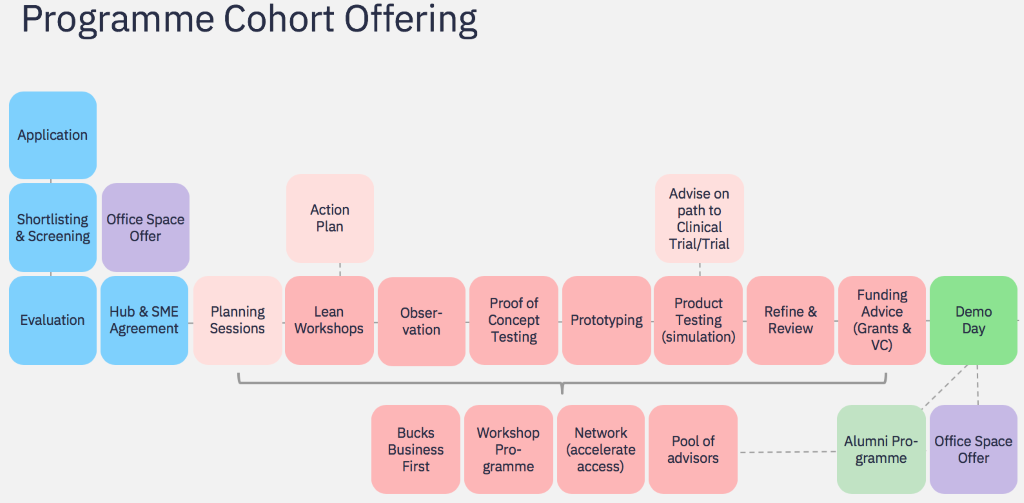
Throughout the lifetime of the programme, Bucks HSC Ventures has committed to the following outputs:
110 enterprises receiving support
18 new enterprises supported
20 new FTE jobs created and filled
15 enterprises cooperating with research institutions
5 enterprises supported to introduce new to the market products
5 enterprises supported to introduce new to the firm products
Aspect 3: Results
There have been several outcomes from Bucks HSC Ventures’ engagement with SMEs which have led to greater local growth and regeneration within the greater Buckinghamshire area.
The enterprises receiving support through the Programme have been enthusiastic about the quality of delivery, the access they have received to health and social care decision makers and the collaborative response they have received, particularly from the Buckinghamshire Healthcare Trust and Buckinghamshire Council. Highlights of some of these responses can be found here https://vimeo.com/396656175 (password: hsc20).
According to the founder of Binding Science Ltd who was a participant in cohort 2, “One of the best parts of this programme was facilitating introductions to relevant stakeholders. This support is utterly invaluable, particularly when trying to access organisations that are as labyrinthine as the NHS and the social care ecosystem.”
Key Milestones and achievements from the programme (Spring 2018 – Summer 2020):
15 knowledge exchange workshops successfully facilitated, some of the recordings can be found here: https://hscventures.co.uk/webinars/
2 x six-month cohorts of SMEs supported (a third one is underway)
2 x venture showcase events involving the greater Buckinghamshire area
Ufonia (https://www.ufonia.co/) - Innovate UK funding (£700k)
Keratify (https://www.keratify.com/) - Innovate UK funding (£463k) & Research collaboration in progress with Bucks Healthcare Trust
Good Boost (https://goodboost.org/) - won the SBRI MSK Technology funding award
Binding Sciences (https://uk.linkedin.com/in/keithbinding) - collaboration agreement with Bucks Healthcare Trust & future Bucks research project scope
DeepX Health (https://www.deepxhealth.com/) - collaboration agreement with Bucks Healthcare Trust & future Bucks research project scope
Good Boost implementation into Buckinghamshire leisure centres, working on support from local social prescribing system
Good Boost hired 4 FTE’s during the cohort programme
Keratify hired 5 FTE’s during the programme cohort with another two who joined in May
Caremark (https://www.caremark.co.uk/locations/aylesbury-and-wycombe) in early stages of discussion about running a trial with the Bucks Council
To date, midway through the programme, 58 enterprises have received their 12 hours of support (53% of goal), the programme has exceeded the target of new products to market (120%) and the number of full-time equivalent (FTE) hires to the enterprises is 55% of goal. The programme is on track to deliver 100% of its stated outputs.
In addition to outputs, Bucks HSC Ventures activities have had a multiplier effect within the greater region. This initiative has linked more widely with the Buckinghamshire LEP’s Local Industrial Strategy (https://www.buckstvlep.co.uk/our-strategies/local-industrial-strategy/) and is a cornerstone to the LEP’s MedTech strand, which is one of the four pillars of the regional Industrial Strategy. The delivery team has brought together a wider planning group to develop the MedTech strategy for the region and partners include local industry (Janssen/Johnson & Johnson, June Medical and Mediplus), the Buckinghamshire LEP, Bucks Business First, Buckinghamshire Healthcare Trust, Oxford Academic Health Sciences Network and Buckinghamshire Council. The ultimate goal is to paint a joint future vision for growth and innovation within this sector in Buckinghamshire. The aim is to develop a joined-up ecosystem for health and social care innovation, growth and regeneration and Bucks HSC Ventures is the delivery engine for this vision.
For further information, please send queries to lisa.mcginty@bucks.ac.ukk
Public & Community Engagement
Summary of approach
As an anchor institution within the region, Buckinghamshire New University (“Bucks”) prioritises community outreach, inclusion and widening participation at all levels within the institution. Beginning with the Organisation’s strategic plan: “Impact 2022”, down to individual performance reviews, making a positive impact on the lives of students and the community is at the forefront of what we do. It is rooted in a shared understanding of our values and of our historic mission – to be a vibrant, inclusive community that inspires learning, develops potential, widens participation and ambitiously transforms lives. Our impact reaches beyond the mainstream population and even beyond Black and Asian Minority Ethnic (BAME) and we have touched the lives of marginalised groups, such as the Gypsy/Roma/Traveller community.
Aspect 1: Strategy
Buckinghamshire New University (“Bucks”) has a proud 129-year history of transforming the lives of its students through employment-focused and skills-based teaching which enables students from a wide range of backgrounds to achieve their ambitions. We create the conditions for success and strive to be a catalyst in making a positive impact in our communities and on the environment.
We make a positive contribution across four key areas:
Environment- reducing the use of energy, natural resources, and waste;
Philanthropy- financial support of Bucks Students’ Union’s “Big Deal” initiative which provides development opportunities to our students;
Community- volunteering and fundraising with charities in our communities, and outreach work with local schools; and
Workplace- wellbeing and recognition initiatives; promoting equality, diversity and inclusion; and developing our people’s skills.
These pillars form the basis of our corporate social responsibility covenant, which, in turn, forms the very ethos of the University’s overarching strategic plan “Impact 2022”. This plan was developed through a series of facilitated workshops in which the vision was formed, and the University’s values were redefined.
Impact 2022 is rooted in a shared understanding of our values and of our historic mission – to be a vibrant, inclusive community that inspires learning, develops potential, widens participation and ambitiously transforms lives. Our priorities are:
Deliver life-changing education that is accessible to all learners;
Expand our reach working in partnership with learners, communities, partners, employers and the wider society;
Deliver research and innovation that enhances lives and society;
Ensure the University is a learning organisation that continuously improves organisational effectiveness.
This strategy is embedded in the University’s planning and budget cycles as well as in individual performance reviews. Teams are measured against their targets, which cascade from the plan’s strategic goals.
Impact 2022 is also underpinned by our Access and Participation Plan which includes our ambitions to improve equality for all students and facilitate progression within higher education. https://bucks.ac.uk/about-us/governance-and-policies/access-agreement.
The University’s Students’ Union (https://www.bucksstudentsunion.org/) also plays a pivotal role in our public engagement strategy. One of the top 3 Students’ Unions in the UK (NSS 2020), it recognises community volunteering with certificates of achievements for 50, 100, 200, 400 hours completed through an accreditation system.
PROMOTING OUR FACILITIES AND SERVICES TO THE COMMUNITY:
Enquiries from the public come to Bucks through different entry points. If by phone, it is likely received by Reception who either answer the query directly or direct the call appropriately. Most public queries come through our website www.bucks.ac.uk. Each facility has its own dedicated landing page that includes contact details, opening hours and pricing. The following facilities are open to the public or can be hired on an ad-hoc basis:
Aspect 2: Support
SUPPORT FOR OUR ENGAGEMENT STRATEGY:
Bucks allows staff two days paid leave to perform volunteering activities. Additionally, during the COVID-19 pandemic, we provided additional community support to the NHS including care delivery; on-site training; virtual education; free lunches and the use of University facilities.
Staff are also encouraged to include community engagement in their yearly performance review. Additionally, employees are rewarded for their contribution at our annual “Bucks Stars” staff recognition event. Of the 14 categories, there is an “Outstanding Contribution to the Local Community” award.
Other areas that promote community engagement include the Multi-faith Chaplaincy. It is available to anyone who is looking for spiritual guidance or wants to find a place to worship. The team of seven offers pastoral support and acts as a point of contact for local faith communities.
The University has a dedicated wellbeing team of six staff, whose responsibilities are growing as our community outreach expands. The wellbeing team engages with external organisations and students to run a community food bank and the Bucks upcycle scheme, as well as other outreach activities. The University is in the process of hiring two additional Employer Engagement Officers.
SUPPORT FOR WIDENING PARTICIPATION:
1. Study Higher Programme - Study Higher supports young people from Year 9 upwards by providing career advice and the opportunity to learn more about university. It is a government-funded (NCOP/UniConnect) programme and, from 2017 – 2020, the University received £342,000 to run it.
2. Bucks Widening Participation Team - One third of our students are from areas of higher levels of deprivation and our success with these students starts with a small team dedicated to widening participation. This team runs outreach programmes designed to liaise with under-represented groups within the community. Schools involved are chosen based on percentage of free school meals, proportion of children in deprived areas, number of ethnic minority children, proportion of children in military families, and number of children in care.
3. Nursing Cadet Programme - With the objective of widening participation in the field of nursing, the University runs a Nursing Cadet Programme. Its aim is to provide a local workforce pipeline from under-represented communities.
OUR ONLINE PRESENCE TO THE COMMUNITY:
Many public queries are web-based searches on www.bucks.ac.uk. The website is organised using drop-down lists with hyperlinks to the various sections. (See below.)
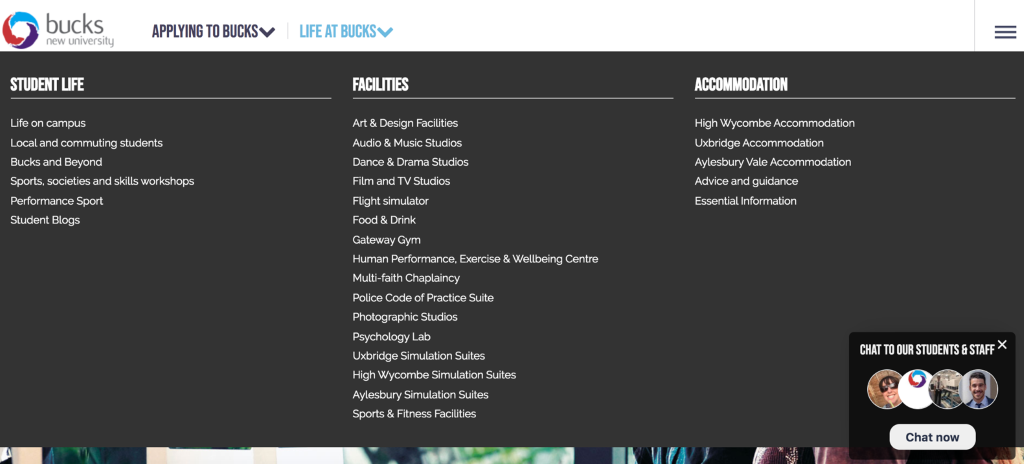
Facilities that are open to the public include: contact details, a timetable and pricing (if applicable).
When navigating the website, there is a pop-up chat function available, meaning the public is only a click away from having their enquiry answered.
STAFF CPD:
Bucks provides many development opportunities to enhance knowledge, skills and behaviours to deliver our organisational strategy, Impact 2022, including:
External courses through the Buckinghamshire Leadership Academy
Apprenticeships
eLearning - 250 modules
Professional qualifications including research degrees
Funding to attend external conferences and training courses
Additional funding available to present at academic conferences
Access to Higher Education short courses, the Academic Professional Apprenticeships and the Post Graduate Certificate in Education
Coaching and mentoring schemes
Access to recognised psychometric tools like StrengthScope
Annual staff development conference
Access to CareFirst, a professional counselling service https://carefirst-lifestyle.co.uk/
Aspect 3: Activity
Whether it’s residential engagements like summer school “tasters” or fitness assessments at our Human Performance Lab, Bucks prides itself on being an anchor institution. Public engagement is underpinned by the University’s strongly held belief in inclusion and diversity.
WIDENING PARTICIPATION ACTIVITIES:
Study Higher - Focusing on POLAR4/Q1 pupils from target schools, groups take part in workshops, Futures Days, and residential visits to Bucks. (https://www.studyhigher.ac.uk/residential).
An impactful activity in the Study Higher programme is our “Simulate your Future” immersive simulation van. This is an interactive mobile unit that provides an immersive experience about people’s journeys into careers. (See photo below.) https://www.youtube.com/watch?v=nO6cP2Ktgj4&list=ULurJZhQ3_WdY&index=297
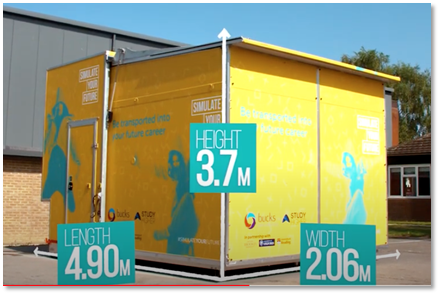
Future Days - Targeting Year 9 students in under-represented communities, the University opens its doors for a day-long programme designed to make them feel comfortable in a higher education environment.
Discovery Days - Similar to Future Days, this programme supports Year 10 students in making their career choices whether it is 6th form, college, apprenticeships and whether or not they would like to pursue a path to higher education.
Outreach Days - The University also runs 25 outreach days per annum in which representatives from the University visit local schools with the goal of breaking down the barriers to higher education.
EXAMPLES OF COMMUNITY-BASED ACTIVITIES:
National Disability Art Collection & Archive (NDACA) - This project brings together 2,500 objects celebrating the history of the Disability Arts Movement on a website and through films and live events at Bucks. (https://bucks.ac.uk/news/2019/may/uks-first-disability-arts-collection-and-archive-opens-at-bucks-new-university)
Woodlanders Lives and Landscape - Preserving craft heritage, the Woodlanders Lives and Landscape project is a partnership with Bucks and the Chilterns Conservation Board. https://www.chilternsaonb.org/woodlanders-lives.html. It is a community-based project to research, document and celebrate the lives of those involved in woodcrafts and in lace making, straw plaiting and tambour beading in the Chilterns in the 19th and 20th centuries.
Marginalised Communities – The University’s Professor of Social Policy and Community, works extensively in the field of social inclusion, ethnicity, equalities and social justice with an emphasis on collaborative research with communities at risk of marginalisation, racism and ‘othering’. She develops action programmes with vulnerable migrants; LGBT+ faith groups; and refugee and asylum-seeking women. She is known for her 25+ year’s work with the Gypsy/Roma/Traveller community.
Aspect 4: Results and learning
The results from our community engagement have been far-reaching:
In 2018 we received Gold accreditation for Corporate Social Responsibility (CSR) following an independent assessment by an accreditation panel, which recognised the positive impact that our staff and students make to the environment and in the community. Bucks is proud to be the first University to receive the highest Gold standard.
Managing Director of CSRA, the accreditation organisation, said, “The independent accreditation panel was impressed with the quality and level of the University’s CSR activity. It’s clear that the University takes sustainable and ethical seriously and is determined to set a good example by demonstrating CSR leadership in the HE sector.”
We employ 30 apprentices in a broad range of learning programmes, valued at £250,000.
180 applications p/a from staff to apply for funding for external conferences and courses.
Number of community members who have visited the simulation van = 1,399
Number of staff involved in Study Higher = 4
As a result of our Professor of Social Policy and Community’s efforts in the Gypsy/Roma/Traveller (GRT) community, we convened a roundtable event hosted at the House of Lords in September 2019 to explore how the HE sector could work with this community to enhance access, retention and attainment. (https://bucks.repository.guildhe.ac.uk/17932/) Following the event, Bucks led the development of a network of partners to actively engage with the GRT community. She continues to spearhead outreach programmes in this community resulting in a greater understanding of this marginalised group within mainstream HE. In 2020, she has been short listed in the Times Higher Education Awards for the “Widening Participation or Outreach Initiative of the Year.”
Aspect 5: Acting on results
WIDENING PARTICIPATION:
Bucks is pursuing new methods of online interaction with young people in under-represented communities. We are also expanding our out-bound activities targeted at specialised military schools, disabled schools and institutions that work with the Gypsy/Roma/Traveller community. This is in line with the University’s Access and Participation Plan. (https://bucks.ac.uk/about-us/governance-and-policies/access-agreement)
Through our widening participation activities and feedback, Bucks understands that an impactful way of inspiring young adults is by providing relevant role models. The University will start an online mentoring project in collaboration with Bright Side in January 2021.
Additionally, Bucks is developing more immersive films promoting other courses such as Music and Policing for the Simulation Van.
Feedback from the University’s GRT work has influenced the HE sector’s attitudes towards this marginalised community. We are working with a network of HEIs, NGOs, the OfS, NEON and the GRT community itself to assist in developing good practice activities and a pledge to support this community more effectively across the UK. The goal is to increase HE participation within this marginalised community by 10%.
Bucks has also pledged its commitment to the principles of the Advance HE Race Equality Charter (REC), improving the representation, progression and success of minority ethnic staff and students within higher education. As a first action, an internal BAME staff network has been established to provide a platform where staff can learn more about diversity in an inclusive and open environment which promotes connectivity and personal growth.
In line with the UK’s Industrial Strategy, the University understands the need to encourage more participation in STEM. In participation with the Nuffield Future Researchers programme, the University plans to support students from under-represented groups to progress to STEM-related further study.
CORPORATE SOCIAL RESPONSIBILITY:
Bucks will continue to work closely with the Students’ Union to build on our CSR achievements by setting stretching targets, monitoring our progress and learning from other organisations both within and outside of higher education.
According to the former President of Bucks Students’ Union, “The University fully deserves this accreditation, and we hope to use it as a springboard for more impactful projects within our local community and beyond.”
For further information, please send queries to lisa.mcginty@bucks.ac.uk